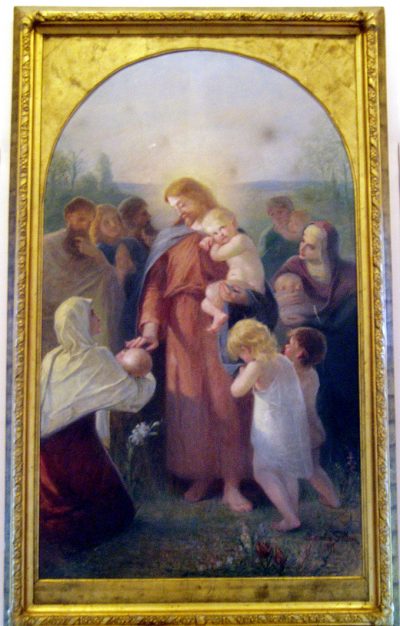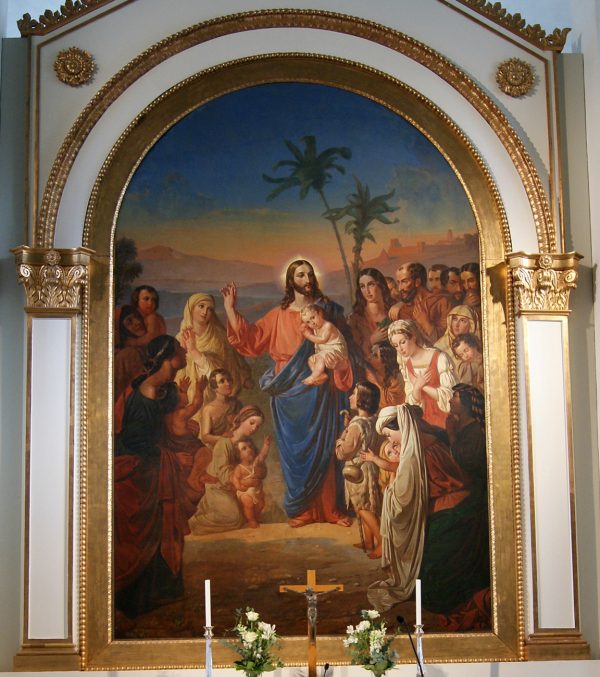Let the little children come to me: Child Motifs according to Alexandra Frosterus-Såltin (1837–1916)

In my PhD research project I explore the favoured and emergent motifs in the Evangelical Lutheran altarpieces of late 19th and early 20th century Finland. One of the key subjects is the motifs including children as part of the central imagery. The motif of Christ blessing the children was virtually absent from the altars of Finnish churches before the middle of the 19th century. Here I briefly introduce the iconography of Alexandra Frosterus-Såltin’s (1837–1916) Let the little children come to me altarpieces and their societal context.
Frosterus-Såltin created almost a third of all the over 200 Finnish altar paintings produced in the era, and thus she had a strong influence on the genre, on the variation of motifs and even on how the altarpieces are seen today. However, her work has not been broadly studied. Research focusing on 19th century women artists has increased progressively since the 1980’s, but until recently not much attention was paid to them if they were operating outside field of Modernism. Furthermore, the majority of late 19th century church art was perceived as uninteresting, mainly due to its popular, made-to-order nature and the extensive use of well-known prints of religious paintings as its models.
The altarpieces of Frosterus-Såltin at first seem conventional, but a closer inspection reveals variations and nuances that have renewed the depiction of the child motif in Finland. It goes without saying that children play a crucial role in any depictions of the motif. However, Frosterus-Såltin had a distinctive way of depicting the scenes, with children in direct contact with Jesus. She painted the motif three times, and though the details differ in every work, the main composition of the figures remains. Jesus is standing in the midst of a crowd of people who have brought children to be blessed. What is noteworthy is the position of Christ in relation to the children. In all of her paintings, there is a small unclothed child in Christ’s arms. There are also other children and women in His vicinity. The disciples, on the contrary, are in the background, unlike in the works of many other artists.
In Finland, it was more common for depictions of the motif to present Jesus in a sitting rather than in a standing position. Besides Frosterus-Såltin, only Robert Wilhelm Ekman (1808–1873) realised in 1848 a work in which Christ is standing and supporting a child on his arm. Nonetheless, the peaceful atmosphere and the focus on the children in Frosterus-Såltin’s paintings differ from Ekman’s work, where the attention of both Jesus and the viewer is on the disciples. In her works, another interesting element is the way in which Jesus is holding the child. The positions and gestures of the figures associate her depiction with the iconographic type where the Virgin Mary is holding the Baby Jesus in her embrace. In a way, the personal connection between the child and Christ sanctifies the child. It elevates childhood, and childlikeness as the ideal state of humanity. Simultaneously, the unclothed child figure presumably symbolises the human soul, a convention that has existed in Christian art for centuries.

As I see it, the emergence of the child motif on the altar in the late 19th century is connected with the new understanding of childhood as a separate phase of life, with the emphasis on its special quality. According to Romantic thinking, the child was thought of as being in a closer relation with God. In Finland, Zachris Topelius (1818–1898) put forward a Romantic idea of the child as a symbol of heavenly purity, a being who was still in the natural state of self-unconsciousness and therefore innocent. Topelius saw that a child had something left of the original, undivided and asexual human being.
The increased use of the motif in the era can be distinctly seen a part of the discussion on the societal importance of the family unit, commenting on it from the viewpoint of religion. In Frosterus-Såltin’s works Jesus appears in both of the parents’ roles: he has simultaneously the iconographical indicators of both the Good Shepherd and Madonna. The Romantic philosophy considered both sexes as defective and supplementing each other. Conversely, Jesus was flawless and served as a model for all human beings. Moreover, infant mortality was still common, and the thought of children’s immediate connection with God also made it easier to cope with the loss of a child. Thus, the motif can be seen not only as a reminder of the parents’ childcare responsibilities but also as solace for them.
In Frosterus-Såltin’s executions of the motif, the emphasis placed on women is a choice. The composition correlates with how the mother’s role as the primary caretaker of the child and the cohesive force in the family was emphasized in that era. Gradually, the full responsibility for children was transferred to the mother, and the father was left with the role of supporter. This tendency was also seen more generally in the art. The rise of the motif in altar painting was thus associated with the development of the surrounding society.
Ringa Takanen (MA) is a PhD Candidate at the School of History, Culture and Arts Studies (Art History) of the University of Turku, Finland.
Image 1: Alexandra Frosterus-Såltin: Let the little children come to me, 1897. Oil on canvas. Särkisalo church. Photo: Ringa Takanen.
Image 2: R.W. Ekman: Let the little children come to me, 1848, Oil on canvas. Old Church of Helsinki. Photo: Helsinki Cathedral Parish / Liisa Airaksinen.
This text is based on the peer-reviewed article: Takanen, Ringa (2016), ”Pyhä lapsuus ja äidillinen Kristus – Perinteisten roolien muutos Alexandra Frosterus-Såltinin alttaritaiteessa modernin kynnyksellä.” Tahiti – Taidehistoria tieteenä 2/2016. Helsinki: Taidehistorian seura.
